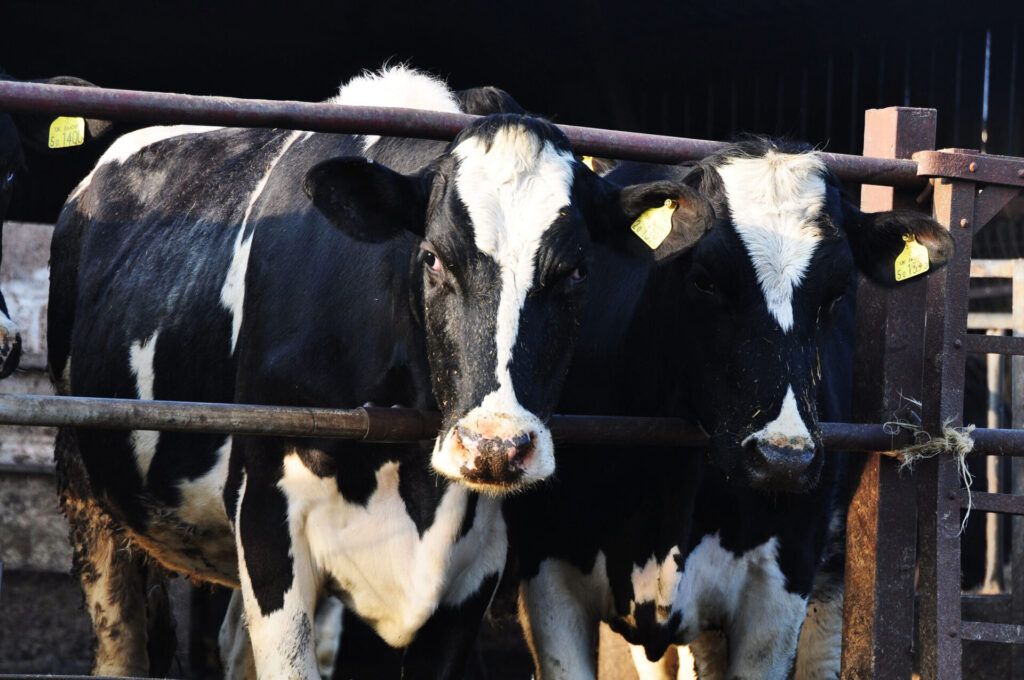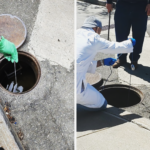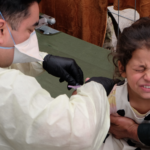Preventing the next pandemic should start with protecting farm workers
By Amy K. Liebman, Claire Hutkins Seda | September 13, 2024
 A cattle farm. Credit: Lewis Clarke
via Wikimedia Commons. CC-BY-2.0.
A cattle farm. Credit: Lewis Clarke
via Wikimedia Commons. CC-BY-2.0.
It goes by many names—avian flu, bird flu, H5N1, and highly pathogenic avian influenza or HPAI—but, whatever the name, there is good reason to sit up and pay attention to it right now. Back-to-back years of heavy infection have led to the culling of almost 100 million chickens and other poultry in an attempt to minimize disease spread on massive-scale US poultry farms. The virus has resulted in millions of wild bird deaths and an unknown number of deaths among the 200 mammal species in the United States that have been confirmed to carry avian flu—and it’s still spreading. Now it’s showing up among people, particularly workers on poultry and dairy farms.
This year, avian flu jumped from birds to cattle, then transmission began occurring cattle-to-cattle, and finally, from cattle and birds to people. Between 2022 and March 2024, one poultry worker fell ill. Since March 2024, four dairy workers, nine poultry workers, and one person who did not work with cattle or poultry have been confirmed infected. But a recent study made it clear that it’s very likely that far more workers have gotten sick. That’s a big problem, particularly on dairy farms, the newest ground zero for avian flu.
An estimated 79 percent of the milk supply in the United States comes from immigrant labor. Workers, largely from Mexico and Central America, work on dairy farms with cows, ensuring they are milked and fed. This essential workforce is once again on the front lines of an emerging health crisis. Government agencies responsible for public health and occupational safety, by and large, have not viewed the H5N1 outbreak through a lens of worker health and safety. Instead, agencies have focused on the area they serve best: the risk the avian flu virus poses to the health and well-being of the general public. The current assessment of the Centers for Disease Control and Prevention (CDC) is that this risk remains low. Yet, prioritizing a general population-health lens is leaving workers at risk.
As public health agencies and organizations build up their response to this disease in the dairy industry, to make sure avian flu doesn’t spread further and doesn’t mutate into something more severe, they must focus on the needs of workers.
Dairy workers who have been infected with avian flu have so far experienced mild symptoms: conjunctivitis (known to parents everywhere as pink eye) and/or some upper respiratory symptoms. This outbreak of the disease has not caused any human deaths or even hospitalizations among dairy workers, although historically H5N1 has caused pneumonia and death in other countries. Mild symptoms, partnered with limited testing availability, may have resulted in more workers contracting avian flu than publicly recognized. With a mild disease, this doesn’t seem like a big concern, but public health must always look three steps ahead and recognize that ongoing infection gives avian flu the opportunity to mutate to be more deadly.
The CDC, the Food and Drug Administration (FDA), and the US Department of Agriculture (USDA) are working with state health departments and other state agencies to test dairy herds and, to a limited extent, workers and milk. The federal government has largely left it to the states to decide the extent of their responses. And public health officials in states such as Colorado and Michigan have responded effectively in ways that have aided understanding of H5N1’s spread and its impact on workers.
As of September 3, 197 herds in 14 states have tested positive, and H5N1 in dairies continues to spread. But testing has been limited. The CDC reported that only 230 workers have been tested to date. The CDC and health departments have also monitored over 4,500 individuals exposed to infected birds, poultry, dairy cows, and other animals for 10 days after exposure. Additionally, the CDC is monitoring influenza reporting in outpatient and emergency department settings and testing for the virus in wastewater to help determine its spread. Meanwhile, the Food and Drug Administration is sampling retail dairy products and ground beef to test for the presence of the virus, and the Department of Agriculture is pushing for increased biosecurity and more surveillance measures on farms.
But workers’ needs must get more attention.
In response to the dairy farm outbreaks, the CDC issued guidelines encouraging dairy workers to use personal protective equipment (PPE). It asked state health departments to provide stockpiled N95 respirators to farms that requested them. While well intended, the CDC’s suggestions were seen as unrealistic for workers laboring in hot and wet environments where they are regularly exposed to cow feces and urine. The agency did not emphasize the need for different PPE or several N95 respirators per worker or per shift, and training on how and when to properly use PPE. Most importantly, the guidelines put the onus for worker protection on the workers themselves and not employers.
Even as researchers have begun to understand the routes of exposure in dairies and how mammary glands and unpasteurized milk play important roles, new guidance or emphasis on different types of protections have been absent. Almost eight months into the outbreak, beginning this October, the CDC plans to fund more widespread outreach to workers to educate them in a language and cultural context they understand. The focus will be on H5N1 and seasonal flu. This is a welcome turn in the public health response to avian flu, as the CDC initially depended on already-stretched community groups, often at their own expense.
But several obstacles remain in the path before public health agencies can adequately engage vulnerable farm workers to understand the spread of H5N1 and mitigate its harms.
The gist of the response depends on states working closely with producers. That has often left state officials trying to figure out ways to reach dairy producers and, through the producers, workers. But many producers have been leery of intervention. They fear for their livelihoods despite voluntary programs that offer some financial support. Agricultural employers have long resisted regulatory protections addressing workplace health and safety and have voiced concerns about interference in farm operations or exposure of working conditions that then requires them to take action.
During COVID, across the nation, many farm owners recognized the utility of protecting farmworker health, and public health authorities, clinicians, and employers formed new partnerships and collaborations. Some areas of the country have continued to build on those relationships and have established long-term trust as well as communication channels that can be used in a future public health crisis. Colorado and Michigan offer examples of states that have effectively navigated H5N1 with farm owners.
But even with the cooperation of producers in some cases, engaging farmworkers themselves will still be a challenge.
The talking points of federal and state officials trying to address the emerging H5N1 situation commonly include the mantra of “workers are scared” or “hard to reach.” However, the real issue is that historically public health has hardly reached this population because workers are geographically distanced in rural areas, speak languages other than English, and have precarious immigration statuses that make them fearful of losing their livelihoods. Effective outreach often requires trusted, culturally familiar, messengers and a nuanced approach to build the trust critical to any intervention.
Building trust takes time—but it can be done. After the initial deadly toll COVID inflicted on farm and food workers, many agricultural worker communities avoided major outbreaks by building partnerships among farm owners, workers, and community health centers as well as by providing education and connections between public health authorities and farmworker communities through trusted messengers. Farmworkers were recognized as essential workers and were prioritized for vaccines, personal protective equipment, and other preventative measures due to their higher level of risk.
But responding to H5N1 requires more than just building trust and connection.
The systems in which dairy workers toil are not sufficient to protect them from harm. For example, most workers in the United States have the legal rights to unionize, earn a minimum wage, earn overtime pay, and receive mandatory rest breaks—but many farmworkers are exempted from these workplace basics through what’s termed “agricultural exceptionalism.” When it comes to health and safety, farmworkers are afforded fewer protections than other workers. And the lack of these basic rights is a public health threat: A low-income worker who is not guaranteed paid sick leave may have no option but to come to work while sick. Only a few states have stronger protective standards in place for agriculture. Given these historical exclusions, it is no surprise that the Occupational Safety and Health Administration (OSHA) has been largely missing in action from the federal agency response to H5N1.
Most dairy workers are immigrants, and many lack authorization to work in the United States. These workers are often afraid to speak up, even when their workplaces are dangerous, for fear of losing their jobs or being deported. Numerous barriers—cost, transportation, availability during non-work hours, language, cultural differences, unfamiliarity with the US health care system—prevent workers from accessing health care even when they desperately need it. These structural disparities need to be addressed so that dairy workers can have safe and healthy workplaces, before, during, and after any public health crisis.
Regardless of the nature of the next pandemic—whether it’s H5N1 or something else—farm and food workers will always be essential to keeping food on tables in a time of crisis. To best address the current avian flu outbreak, and to prepare for future outbreaks, the United States should build public health and health care infrastructure with the needs of these workers in mind. Public health must include worker-centered immigration reform and emphasize worker safety. Worker health and safety should not be a side issue during the H5N1 outbreak. It should be a central concern.
Together, we make the world safer.
The Bulletin elevates expert voices above the noise. But as an independent nonprofit organization, our operations depend on the support of readers like you. Help us continue to deliver quality journalism that holds leaders accountable. Your support of our work at any level is important. In return, we promise our coverage will be understandable, influential, vigilant, solution-oriented, and fair-minded. Together we can make a difference.
Keywords: H5N1, agriculture
Topics: Biosecurity
















